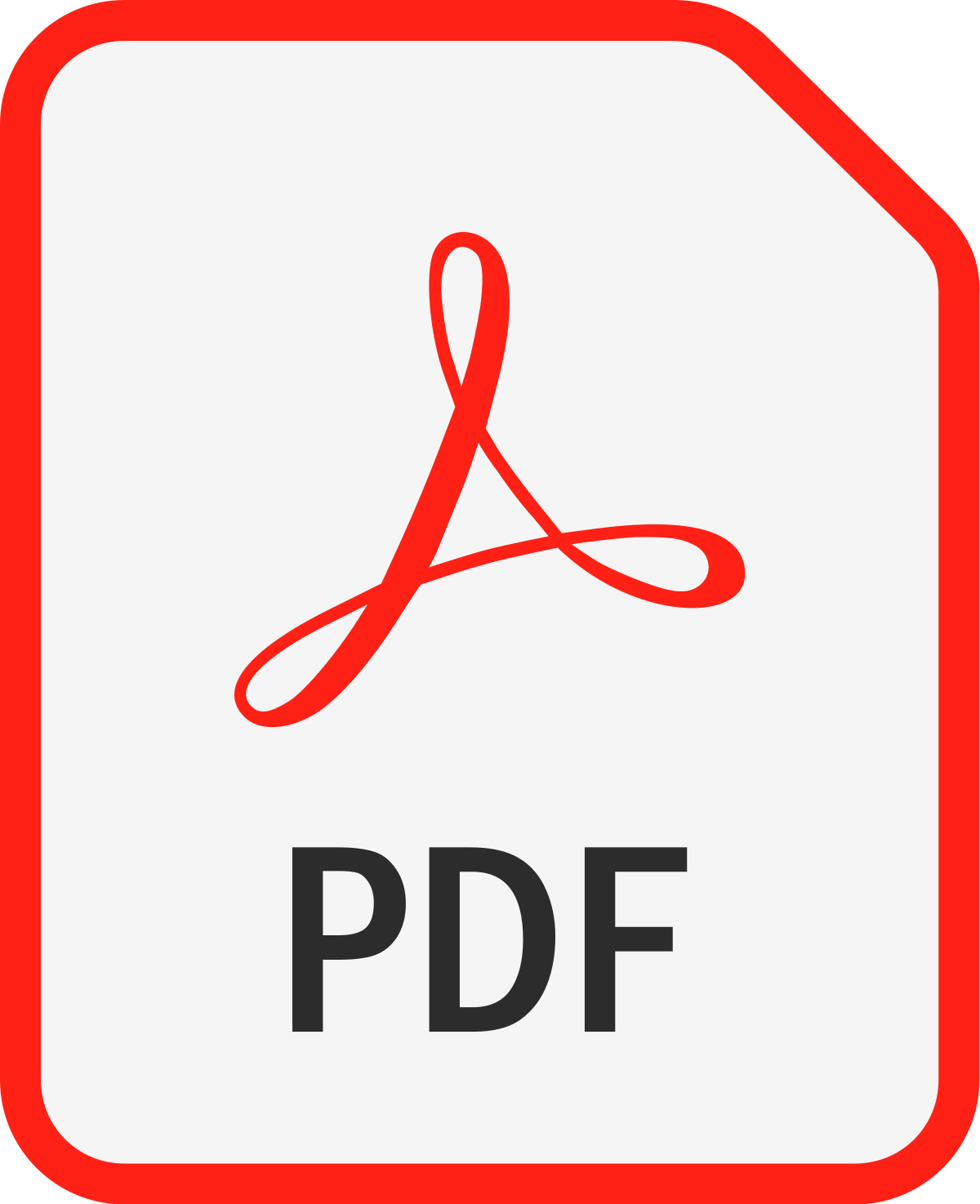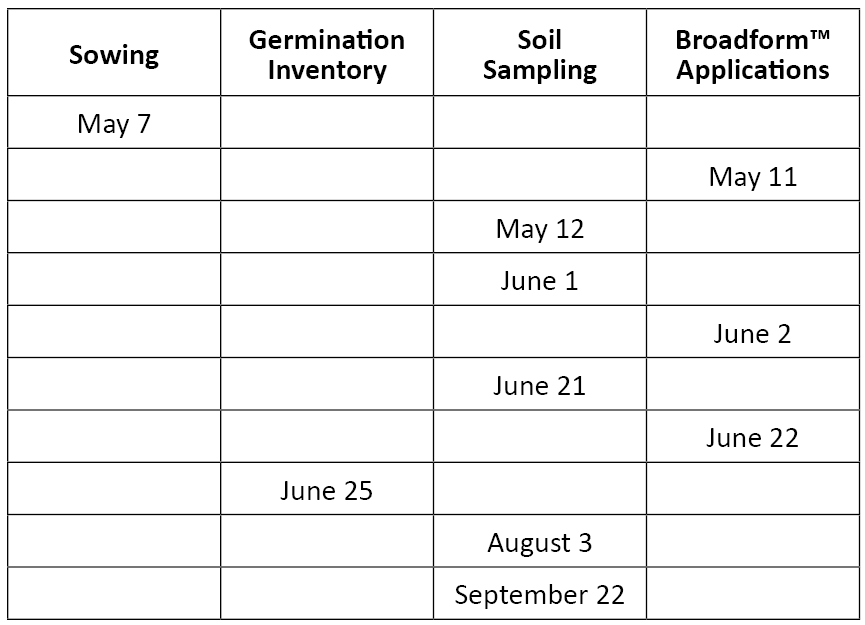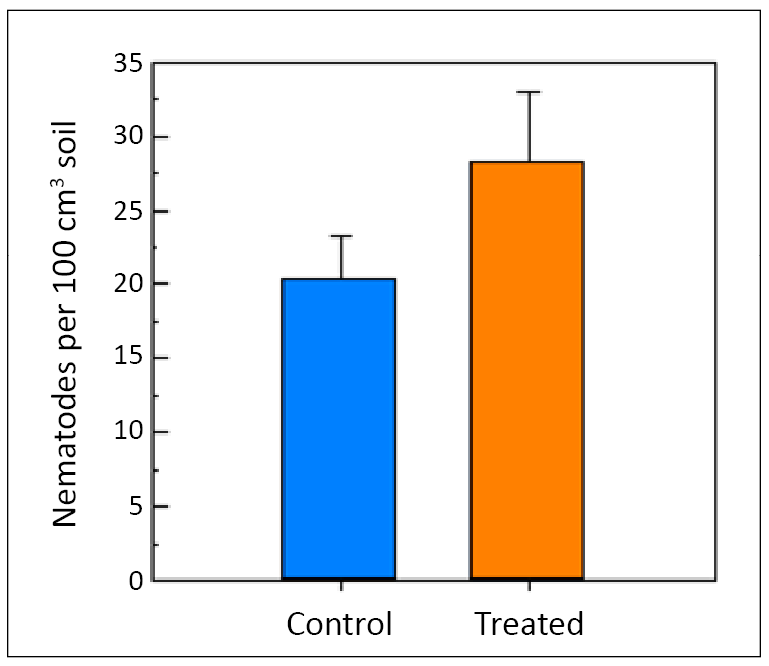Research Report 22-02 
A Second Trial to Determine the Effect of Multiple Applications of a Non-Fumigant Nematicide (Fluopyram) on Nematode Control and Loblolly Pine Seedling Characteristics
Nina Payne, Tom Stokes, and Gene Bickerstaff
Introduction
This trial is the second in a series to test the effect of a non-fumigant nematicide on nematode populations in a bareroot loblolly pine nursery, and on characteristics of loblolly pine seedlings grown in the trial area. After the first trial in 2020, two modification recommendations were made for future studies: 1) to reduce the number of treatment options and applications and 2) increase the number of replications and size of the area in the trial. This second recommendation is important because reliable estimates of nematode populations are notably difficult to obtain (Dinardo-Miranda and Fracasso, 2010).
The development of new non-fumigant nematicides for use in agricultural crops is an expensive process, so new products do not regularly appear on the market. Most of these are tested and used in high-value crops due the expense in developing them. One new Bayer fungicide product on the market, however, is Broadform™, containing 21.4% fluopyram and 21.4% trifloxystrobin. Fluopyram was registered by Bayer CropScience in 2012 and is labeled for disease control use in ornamentals, turf, agricultural crops, landscapes, and bareroot and container crops in nurseries. Although loblolly pine has not been specifically evaluated for inclusion on the product label, Christmas trees are listed as safe for Broadform™ applications.
In product testing, Broadform™ was found to control nematode populations in turf applications (Crow, et al. 2017). Subsequent research showed that fluopyram is nematistatic, impairing or disrupting host-locating and/or feeding behavior (Faske and Hurd, 2014). In 2018, an amended Broadform label was accepted by the EPA, and includes the following statement:
“For control of diseases of turf, ornamentals and crops and for the protection against damage caused by certain plant pathogenic nematodes.”
The second ingredient in Broadform™ is trifloxystrobin, which was tested for fusiform rust control by the SFNMC in 2019 and 2020 with no negative effects on pine seedling characteristics (Nadel, et al. 2021).
After the 2020 Broadform™ trial conducted by the SFNMC was completed, the decision was made to repeat the trial in 2021 with modifications. Although the 2020 trial did not provide nematode control information, it did provide data showing that loblolly pine seedlings are tolerant to the product, with no differences in seedling characteristics when comparing nontreated control seedlings to those treated under three spraying regimes (Payne, et al. 2021). Modifications to the trial are described further in the section below.
Methodology
This trial was designed in 2021 after results of the 2020 Broadform™ trial were available. Its purpose is to test the effect of fluopyram on nematode populations and on loblolly seedling characteristics when treated with the product. The study was installed at the same nursery used in the 2020 trial, the ArborGen Nursery in Bullard, Texas. Previous trial operations included three spraying regimes with rates varying from 6.75 ounces per acre to 13.5 ounces per acre and number of applications ranging from two to four. In this trial, one spraying regime was used and the number of replications increased from four to nine. Soil samples for nematode analysis were collected five times over the growing season.
The trial was located in an area of the nursery fumigated in 2019 with 240 pounds per acre of methyl bromide. Each plot was 100-feet by 3-beds wide, with non-treated control plots located in the same unit as the treatment plots. Treated plots were sprayed with 8 ounces per acre of product at sowing, then with 11 ounces per acre at 21 days post-sowing, then with 8 ounces per acre at 42 days post-sowing. The operational schedule for the 2021 trial is listed below:

Germination counts in each plot were made by nursery personnel in June, with results in Table 1. Soil samples were processed at the Auburn University Nematode Lab. Results of nematode counts and identification are found in Figure 1. In December 2021, seedling samples from middle beds of each plot were collected by the nursery staff and shipped to the SFNMC lab in Auburn for processing. Measures of root collar diameter, shoot height, shoot dry weight, and root dry weight were made on sample seedlings from 18 plots (9 control + 9 treatment), as well as counts of seedbed density from each plot. Results can be found in Table 1. All data was analyzed and examined using Duncan’s Multiple Range test and Dunnett’s t-test at alpha = 0.05.
Results
Nematode populations from soil samples collected in non-treated control plots from May 12 to September 22, 2021, showed populations ranging from a high of 38.4 per 100 cm3 of soil in May to a low of 10.0 per 100 cm3 of soil in late June. Treatment plots contained populations ranging from a high of 47.8 per 100 cm3 of soil in May to a low of 12.2 per 100 cm3 of soil in late June. Although nematode counts varied by treatment and date of soil collection, there were no statistical differences between populations recorded in non-treatment control plots and treatment plots. As in 2020, these quantities are considered to be low in the nematode world and may not have provided enough pressure to produce evidence of treatment differences. Of nematodes identified, 82% were stunt nematodes.
Table 1. Bareroot loblolly pine seedling characteristics treated with fluopyram (Broadform™).
 Figure 1. Average number of nematodes per 100 cm3 of soil by treatment from May-September 2021 in fluopyram (Broadform™) trial in loblolly pine seedling beds.
Figure 1. Average number of nematodes per 100 cm3 of soil by treatment from May-September 2021 in fluopyram (Broadform™) trial in loblolly pine seedling beds.
Comparisons of loblolly pine characteristics from the trial area showed no treatment differences in bed density (quantified at germination and at the end of the growing season) or in seedling shoot and root dry weights. There were statistical differences in heights and root collar diameters of seedlings from non-treated control plots to those from treated plots, with seedlings from the control plots larger in diameter by 0.27 mm and taller by 2.3 cm than treated seedlings. These small biological differences, however, may or may not be attributed to effects of the nematicide product since the 2020 trial resulted in no differences in seedling characteristics.
Management Implications
Although populations of nematodes were recorded throughout the length of the trial, these were not of sufficient quantity in either control or treated plots to quantify the effect of fluopyram on them. Seedling quality measurements of heights and root collar diameters, while statistically significantly different, were most likely not biologically different. It is recommended that a third round of trials be conducted to further quantify the effects of fluopyram applications on nematodes and loblolly pine seedlings. An additional recommendation from the nursery manager is to delay the first fluopyram spray application until 14 to 21 days after sowing, with succeeding spray applications made at 14 day intervals.
Acknowledgements
The authors thank Gene Bickerstaff and Cleve Moore and staff at the ArborGen Bullard, Texas Nursery for their willingness to conduct this study. They provided suggestions for modifications then installed, sprayed, inventoried, and collected soil and seedling samples. This trial would not have been completed without their participation.
References
Bayer. Broadform™ label. Retrieved from: https://www.environmentalscience.bayer.us/-/media/prfunitedstates/documents/resource-library/product-labels/specimen-labels/broadform-specimen-label.ashx.
Crow, W.T., J.O. Becker and J.H. Baird. “New Golf Course Nematicides.” Golf Course Management, July 2017.
Dinardo-Miranda, L. and J. Fracasso. Spatial and Temporal Variability of Plant-Parasitic Nematodes Population in Sugarcane. Bragantia v. 69, p. 39-52, 2010.
Faske, T., and K. Hurd. 2014. Sensitivity of Meloidogyne incognita and Rotylenchulus reniformis to fluopyram. Phytopathology 104:4–4.
Nadel, R.L., T. Stokes, N. Payne and S. Enebak. (2021). Nursery trials assessing the efficacy of two new synthetic fungicides for the control of fusiform rust over two years of seedling production (2019 and 2020). Auburn University, Southern Forest Nursery Management Cooperative. Research Report 21-01:14p.
Payne, N., E. Bowersock, T. Stokes and S. Enebak. (2021). The effect of multiple applications of fluopyram (Broadform™) on nematode control and loblolly pine seedling characteristics. Auburn University, Southern Forest Nursery Management Cooperative. Research Report 21-05:6p.




